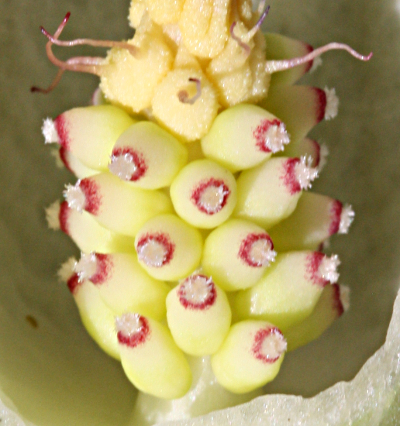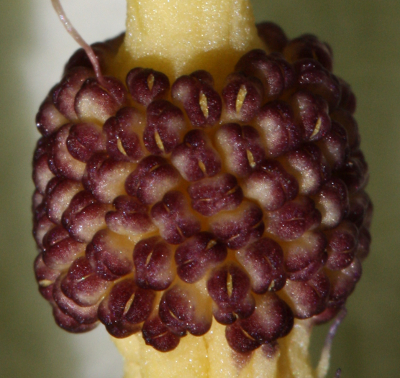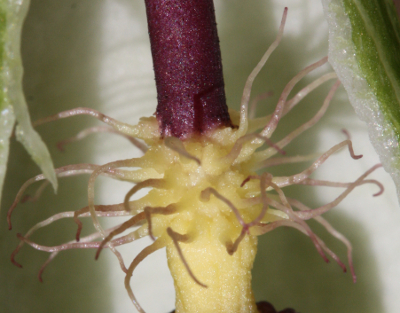Arum |

Flower organs of Arum maculatum

Female flowers of Arum maculatum

Male flowers of Arum maculatum

Ring of hairs (sterile flowers) of Arum maculatum
Comprising some 30 species, arums occur in Eurasia and North Africa. They are perennial herbs with tuber and usually two simple leaves, which are basal, hastate or arrow-shaped, entire and long stalked. They are sheathing the base of the stem.
The spathe is relatively large and tubular rolled at the base. There is a constriction between the erect, oblong-lanceolate lamina, that can be boat-shaped or curved, and the oblong or oval tube. The cylindrical, sessile spadix is shorter than the spathe surrounding it. On it male and female flowers occur in different zones (at base female, above them male), above the male flowers are flowers with sterile, downward looking stamens, which form a blockade for insects. The flowers have no petals, so that the male ones consist of only 3-4 short stamens, the female ones of an elongated ovary with one compartment.
The pollinators are carrion flies or sandflies, lured by the smell of the spadix. They fall into the tube which is extremely smooth because of an oil layer. In addition avoid sterile flowers, that are transformed into hairs, escape from the trap. When trying to get free, they pollinate the female flowers located on the ground, after which the hairs of the barrier wither, and the insect may escape. After that develop from the ovary one- or many-seeded berries.
| Floral formula: |
| ♂ * P0 (A3–4) G0 ♀ * P0 A0 (G1+2°) |
Arum lilies are poisonous in all parts of plant. When consumed, eg. as in confusion with sorrel or spinach or the consumption of the red berries, the contained calcium oxalate can cause a strong burning feeling on the tongue, which can also swell. At stronger poisoning occurs nausea and vomiting or cardiac arrhythmias and convulsions and paralysis of the brain and spinal cord. The toxic effect disappears when dried or cooked.
Historical publications
Theophrastus (371–287 B.C.) reported in his Natural History, the tuber and the leaves of Italian arum (Arum italicum) are edible, if they were cooked in vinegar.
Pliny (about 23-79 AD.) wrote about a plant that will called in Egypt Aron, it has leaves like the dock, thick stems and a soft root. Some would argue that it is the same as Dracontium (Dracunculus vulgaris), but Arum would have a much larger root. In Dracontium it was rolled up like a dragon, hence the name. In addition to some medical applications, he noted that cheese is best stored in leaves of Arum.
Dioscorides (1st century AD.) made the distinction between the two species Arum italicum and Arum maculatum. About the first species, he wrote that it had ivy-like, white spotted leaves. The stalk was mottled like a snake, and at its top were grapey arranged fruits. The second species would be called Lupha among the Syrians and have similar leaves as the Drakontion (Dracunculus vulgaris), only smaller and not as strong mottled. The white root would be eaten after cooking.
Hildegard of Bingen (1098–1179) recommended the leaves and roots of Arum maculatum eaten raw against the plague, so that the buboes would regress. Against gout salted leaves of arum she believed to be effective. If this does not help, so one should dip the root into boiled honey, and then eat it. Wine, in which the root was boiled, would help against fever, mucus in the stomach and depression.
Leonhart Fuchs (1501–1566) mentioned that the Aron in German "Pfaffenpint" (meaning either monk's hood or monk's penis) would be called. It had leaves like the bog arum, just not as strong mottled. On the stems would grow a pointed thing, therein a cob would be.
Meaning of the species name
- maculatum: lat. maculatus = mottled (leaves)
Interesting notes
Arum palaestinum, an Israeli arum, attracts fruit flies for pollination with the smell of rotting fruits.
Arum italicum, the Italian arum is sometimes cultivated as an ornamental plant.
Arum lilies show, uncharacteristic of monocots, no parallel leaf veins, but a cross-venation like dicots.
The starch contained in the tubers of the arum (about 70%) was used in the past for the production of paste or to starch laundering.